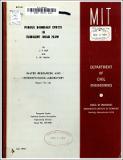Porous Boundary Effects in Turbulent Shear Flow
Author(s)
Ruff, J. F.; Gelhar, L. W.
Download01033132.pdf (8.717Mb)
Metadata
Show full item recordAbstract
A technique of measuring seepage velocities is developed in order to investigate the velocity distribution in a porous boundary exposed to a turbulent shear flow. Measurements are performed in a 1.2 in. thick polyurethane foam lining of 12 in. inside diameter pipe using hot wire anemometer and a helium tracer technique involving the determination of the travel time of the peak concentration. In the shear zone, seepage velocities are determined directly from shielded hot wire anemometer data. In the pressure gradient flow zone, the helium tracer technique is used to measure the seepage velocities. Results of the velocity measurements indicate that the shear effect penetrates a relatively small distance into the porous boundary (approximately 0.25 to 0.30 in.). Measurements of the permeability and longitudinal dispersion coefficient are also made. Three analytical models based upon the eddy viscosity concept are developed in an effort to gain some insight into 'the mechanism relating the turbulent shear flow and the porous boundary flow through the velocity distribution in the boundary. The models are extended to relate the core and boundary flow regions and an attempt is made to predict the friction factor for the pipe. The models provide a reasonable agreement with the observed velocity profile but indicate a decreasing friction factor with increasing Reynolds number whereas the observed friction factor increases. Development of the helium tracer technique for velocity measurements requires additional information concerning the concentration distribution of a tracer in a shear flow. Perturbation methods are used to develop analytical solutions of the convective dispersion equation with an instantaneous point source in a shear flow for both constant and variable dispersion coefficients and the limitations of the solutions are defined. The analysis indicated shear effects caused no distortion on the longitudinal axis and the distortion due to dispersion was insignificant for the dimensions used in the experiments.
Description
Prepared Under National Science Foundation Engineering Division Grant No. GK-4180
Date issued
1970-07Publisher
Cambridge, Mass. : Water Resources and Laboratory, Dept. of Civil Engineering, Massachusetts Institute of Technology
Other identifiers
126
Series/Report no.
R (Massachusetts Institute of Technology. Department of Civil Engineering) ; 70-40.Report (Ralph M. Parsons Laboratory for Water Resources and Hydrodynamics) ; 126.